‘Killers of the Flower Moon’: Lily Gladstone, Leonardo DiCaprio, Robert De Niro and Martin Scorsese Discuss the Western Crime Epic

Leonardo DiCaprio and Lily Gladstone star as husband and wife Ernest and Mollie Burkhart in Martin Scorsese's 'Killers of the Flower Moon.' Photo: AppleTV+
Robert De Niro first appeared in a Martin Scorsese picture 50 years ago this month, playing chaotic hoodlum Johnny Boy in Mean Streets, a breakout hit that kicked off what is arguably the most iconic actor-director collaboration since Akira Kurosawa and Toshiro Mifune. Together De Niro and Scorsese’s half-century of collaboration led to Taxi Driver, Raging Bull, Goodfellas and more. Killers of the Flower Moon, which opens in theatres October 20, is their tenth movie together.
“I made good decisions sometimes, not all the time,” De Niro, 80, says, wryly commemorating his collaboration with a guy he knew from around their Little Italy neighbourhood in New York as a teen. “I have a long-standing relationship working with Marty. That’s because we have fun working together.”
We’re in a penthouse suite at the L’hôtel Barrière le Majestic in Cannes, the day after the première of Killers of the Flower Moon. The film is about a century-old “reign of terror” committed against the Osage Nation in Oklahoma, an Indigenous community that was among the wealthiest in the U.S. after oil had been discovered on its lands. De Niro plays Bill Hale, one of many white settlers orchestrating the murders of Osage members, alongside his dim nephew Ernest Burkhart (Leonardo DiCaprio, 48), as part of an insidious plot to inherit their wealth.
De Niro speaks during a series of roundtable interviews along with his co-stars DiCaprio and Lily Gladstone, 37, who plays Ernest’s wife Mollie Burkhart, the Osage woman caught in the crosshairs of Hale’s plot.
The following day we spoke to Scorsese, 80, in an exclusive interview that appears as the cover story in the current (October/November 2023) issue of Zoomer magazine, which is available now. In that feature, Scorsese and his stars discuss the filmmaker’s legacy and how his personal experiences and the themes he explores throughout his body of work accumulate in Killers.
Below are some selected conversations from our interviews with De Niro, DiCaprio, Gladstone and Scorsese – speaking in Cannes long before actors went on strike in July – about the history behind Killers, the dynamic between their characters and the efforts they made to honour the Osage community while telling their story.
No White Saviours
Originally, DiCaprio was set to play Texas-Ranger-turned-Bureau-of-Investigation-agent Tom White in the film. The character, who was eventually played magnificently by Jesse Plemons, is the hero in David Grann’s non-fiction book Killers of the Flower Moon: The Osage Murders and the Birth of the FBI, upon which the film is based and to which the original script hewed closer.
DiCaprio, a producer on the film, and Scorsese overhauled the project, rewriting the screenplay so that it would depart from white saviour tropes and be told from the perspective of those living inside the terror. The rewrite centred more attention on Mollie who, while married to Ernest, witnesses her sisters and mother passing away under suspicious circumstances.
During that time, members of the Osage Nation, who had no avenues for justice, made long-ignored efforts to get Washington to help with the “reign of terror” in their community. “It took years for the FBI to ultimately come to that community,” says DiCaprio, comparing the lawlessness at the time to the Wild Wild West. “There was a group of incredibly entitled racist individuals that thought that the law didn’t apply to them.”
“In a lot of ways, that’s still actually true,” says Gladstone, bringing up the epidemic of missing and murdered Indigenous women. The actress, who gives a commanding performance as Mollie Burkhart, sits next to her co-star and discusses the systems in place that still make Indigenous communities vulnerable to white-settler violence.
She refers to the 1978 Oliphant v. Suquamish Indian Tribe U.S. Supreme Court decision that still restricts tribal police from being able to prosecute anybody who is not an enrolled member of a tribe. “A white man can go to a reservation, rape and murder an Indian woman. You would need the FBI – because it’s federal land in the United States – to come and intervene,” says Gladstone.
“Everything you see in this film did happen 100 years ago and is very specific to the ‘reign of terror’ in this history. The origin story of the FBI is the murder of native people, and in this story, you see that prominently featured with women. But in ways, it is all still happening. It’s still that lawlessness. We’re still restricted in our sovereignty.”

Scorsese on the Pope’s Apology
Last summer, Pope Francis visited Canada, issuing an apology on behalf of the Catholic Church for the genocide against Indigenous people and their culture, and for abuses committed in residential schools, where children were forcibly removed from their homes and stripped of their identities. The apology followed the discovery of mass unmarked graves at residential schools across Canada.
I bring that up with Scorsese, who says that Killers was wrapped before the Pope’s apology. He doesn’t mention that, however, as a way to get away from the conversation. The filmmaker, who once considered entering the priesthood, has long been grappling with how religion, throughout history, tends to spread colonial violence.
“It goes to Silence doesn’t it?” Scorsese asks, referring to his late-career masterpiece about Jesuit priests in Japan, whose mission to spread the word in a culture they didn’t understand only leads to more suffering. “In terms of how they presented the gospel, the Good News, that may not have been the way. Maybe the way was to follow the example of somebody who behaves a certain way. I’m afraid that the [residential] schools just seemed to feed into a system of destroying who they are, destroying their very souls, in a way.”
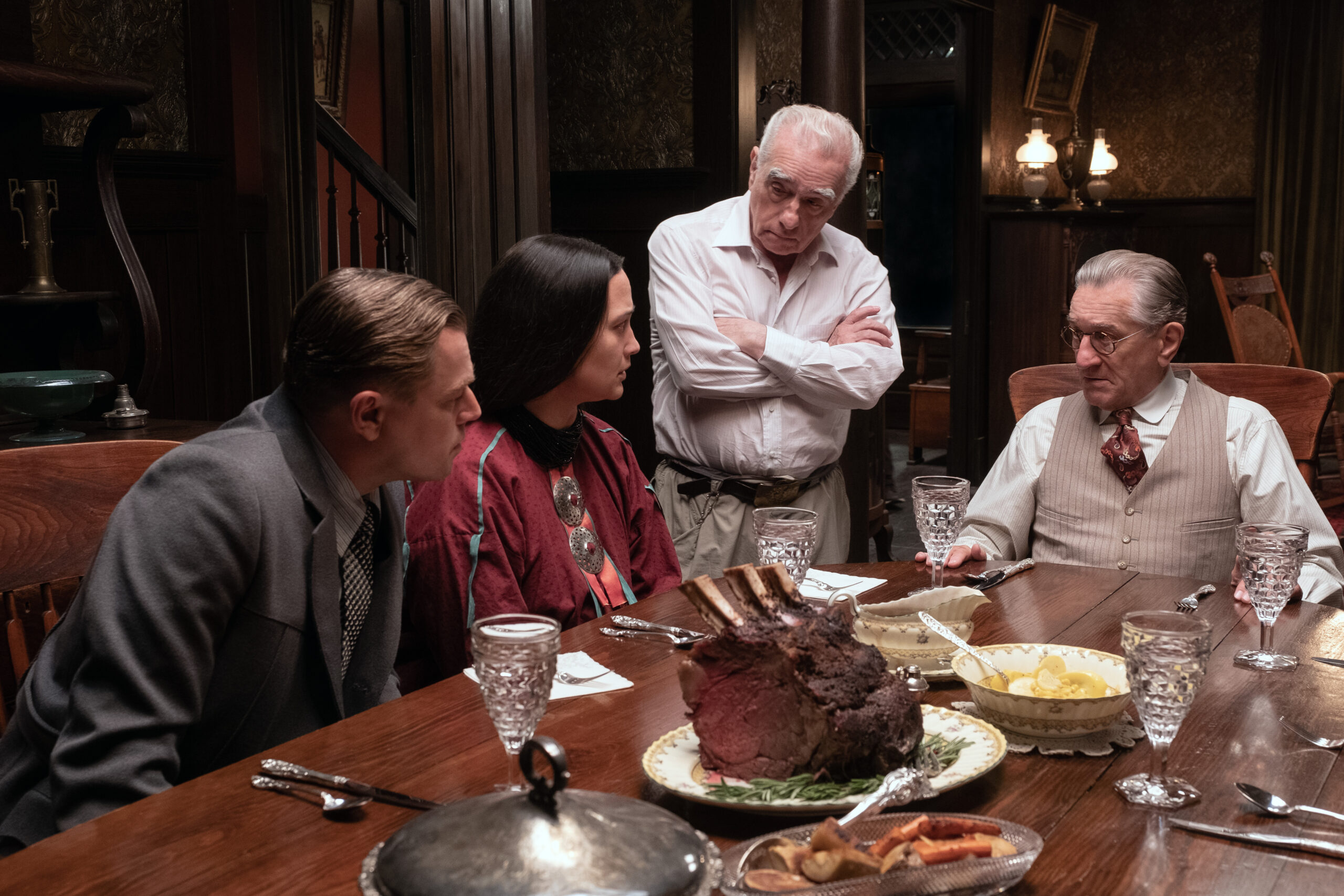
Scorsese, starts dipping into his encyclopedic knowledge of film history, using cinema as his language when he’s searching for answers. He mentions Black Robe, Bruce Beresford’s 1991 Canadian film about 17th-century Jesuit priests in Algonquin communities, citing it as a cinematic touchstone on the subject. He then thinks back to Fred Zimmerman’s The Nun Story, which stars Audrey Hepburn as a woman of God who becomes disillusioned with her calling. There’s a solemn haircutting sequence in the film when the nuns bring Hepburn’s Sister, Luke, into their fold. He holds that scene up against a moment of debauchery in his own film, The Wolf of Wall Street, when a woman working in DiCaprio’s character’s office allows the men to shave her head for $10,000 — money she purportedly plans to use for breast implants. Scorsese focusses on her face, where she struggles to hold a smile amidst the toxic chaos and humiliation.
“It’s always so important, the cutting of the hair,” says Scorsese, before considering the grave and devastating history behind cutting hair in the residential school context, a punishing ritual to strip away cultural identity. He uses the word mutilation. “It’s not just hair,” he says. “It’s the soul. It really is.”
De Niro on Trump
De Niro brings up the criminally-indicted former U.S. president every time we discuss Bill Hale, his character in Killers. The charismatic and influential rancher, referred to as the “King of Osage Hills,” had a close relationship with the Indigenous population even as he was orchestrating their murders with his nephew Ernest. De Niro describes Hale as so entitled that he felt he had the right to take the Osage community’s lives and their wealth. “They should almost be grateful to him [because] he loves them as much as he does,” De Niro says, imagining Hale’s mindset during our interview and referring to the only other person he feels thinks that way.
“Trump,” says De Niro. “I never thought in the beginning, he was bad. I hated him, as many people hated him, for good reason. But I never realized how genuinely insensitive, stupid …,” he interrupts his laundry list of adjectives for the real estate tycoon turned bumbling head of state.
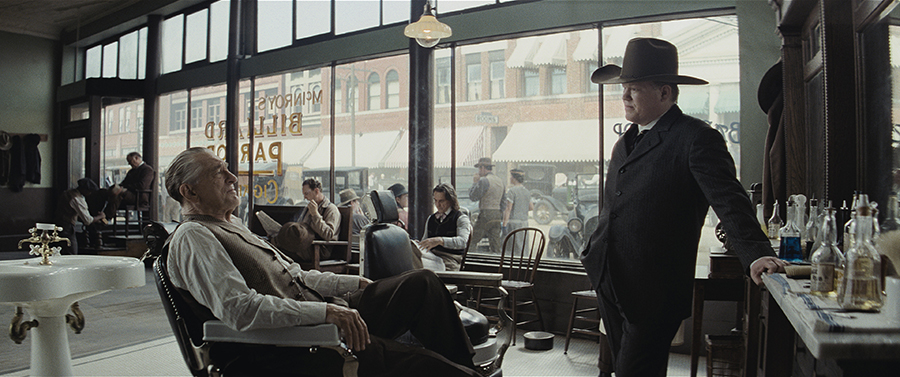
The actor, while sipping on a cup of camomile tea, would go on to describe Trump as a figurehead for fascism who enables white supremacists at a time when many in America are finally opening their eyes to systemic racism after George Floyd’s murder. “There’s something wrong with him,” De Niro says. “Sociopathic, if you will. I didn’t realize it ‘til all the crazy things he said and did as the president of our country.
“What’s even more upsetting are the people who support him, who don’t really want to support [him], but they’re afraid to rock the boat. And they’ll say privately that they hate him. But that’s crazy. You have to stand up.”
Understanding Ernest and Mollie
In the cover story, DiCaprio and Gladstone wrestle with understanding the dynamic between Ernest and Mollie Burkhart against the history of violence happening around them.
Elaborating further, DiCaprio recalls speaking to direct relatives of the real-life couple, including a niece who sat down with Ernest and spoke to him about the murders. “I’m speaking to somebody a hundred years after the death of Anna Brown (Mollie’s sister); 100 years after the Black Wall Street massacre (in Tulsa). It was insane how real and tactile these stories were. They seemed like they happened yesterday.
“As guilty as he was and as cowardly as he was,” DiCaprio continues, “almost no one denied that there was a true love between those two characters. Hale is the embodiment of evil in this. But I think Ernest, in a lot of ways, was incredibly manipulated [and] had a very poor upbringing. That’s the duality of human nature. He loves his wife. He loves his children. But at the end of the day, he is incredibly greedy and opportunistic and willing to risk everything. He ended up paying the price. Deservedly, so.”
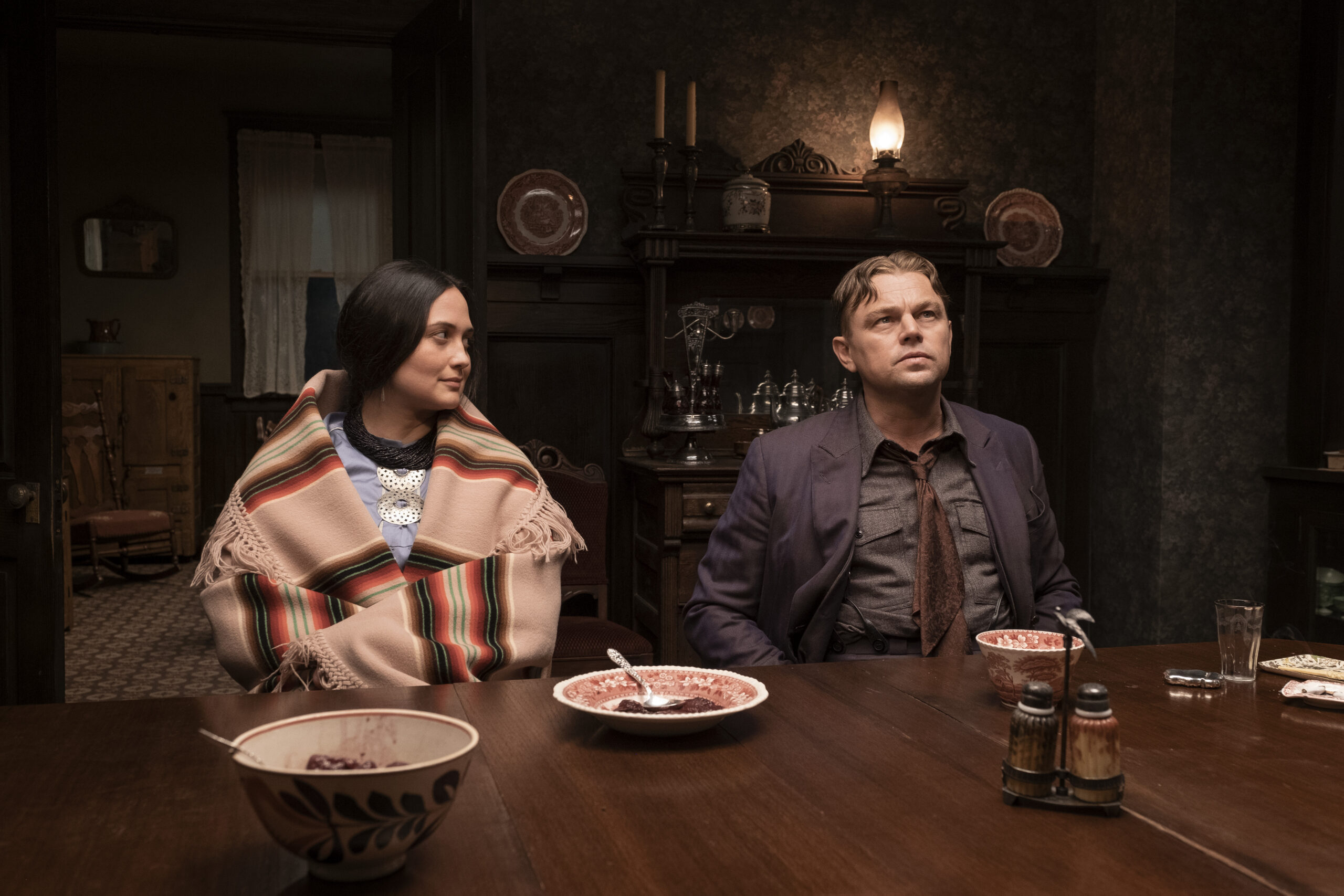
Gladstone, who is of Blackfeet and Nimíipuu heritage, and incredibly well-versed in the history and laws that affect Indigenous communities, provides a key to understanding the romance between Ernest and Mollie. She refers to the guardianship system, which made Ernest an appealing marriage prospect for Mollie while also facilitating his crimes. “Osages with full blood estates declared incompetent needed a white person to manage their finances for them,” says Gladstone, adding that many settlers made a living operating as guardians. You can imagine how such laws empowering white settlers over Indigenous community resources would further the goals of colonialism.
Gladstone goes on to explain that Osage head right holders found it convenient to marry a white person. Having a guardian at home made it easy to sign off on expenses. “Mollie, when she’s vetting Ernest, appreciates that he’s kind of lazy, he’s kind of non-threatening. Like she says, ‘He’s not too bright but he’s good looking.’”
Learning Osage
Everyone from De Niro to Canadian Indigenous actress Tantoo Cardinal, 73, (who we also spoke to me for the cover story) described the daunting task of learning to speak Osage in a way that was respectful and convincing for Killers. Gladstone broke down the process in detail.
“I spent a long time just to make sure that my mouth was doing the right things, because Osage is very different from any Indigenous language that I have even a remote small access point or handle in — my own language included. I didn’t want to put a Blackfoot accent on the Osage language.
“Osage Nation has taken incredible lengths to preserve their language,” she continued, appreciating that this community had the resources to develop an orthography. “I got into a language class with a speaker (Chris Cotê) who was younger than me, which is incredible at this point in time with preservation and revitalization of native languages intrinsically tied through worldview. It’s crucial at this point in history … You learn the worldview along with learning the language.”
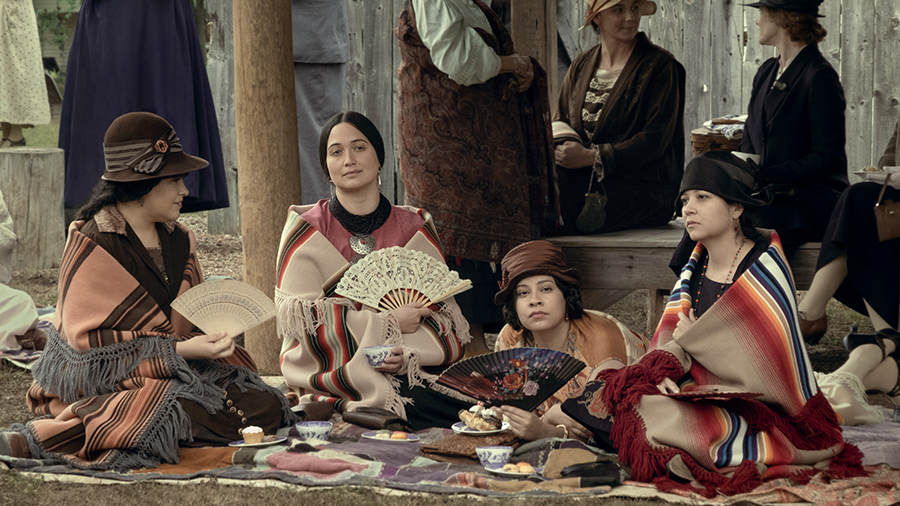
Gladstone says Blackfoot, like Osage, has a syllabic language system that was developed recently at the Glenbow Museum in Calgary under elder and educator Sheldon First Rider’s leadership. She feels encouraged about its effectiveness now after having seen how helpful the Osage orthography was for her own learning.
“We got to the point where we would decide that, since we had these language teachers on board, we would want the certain parts of a scene to be spoken in Osage between our two characters. And bless this guy (she puts an assuring hand on DiCaprio’s shoulder) for just agreeing to do that.
“But then, just in the shorthand, Leo and I had our lines recorded on our phones,” says Gladstone. She describes moments when they would just keep listening to the audio over and over and over in prep to do a scene. “There was the moment of panic in both our eyes toward the end of the one scene where we’d remembered our Osage up to a point, and then, we’re like,” she mimics frozen bodies and eyes going wide. “And then they called ‘Cut!’ right in time.”
From Cannes to the Oscars
Should she be nominated for her performance at the Academy Awards, Lily Gladstone would become the first Native American to score an acting nomination.
“What it means for me is far less important than what it means for all,” she says. “It’s really unfortunate that it’s taken this long. You see these moments throughout the history of the Academy, where we have Indigenous actors nominated for incredible standout performances.”
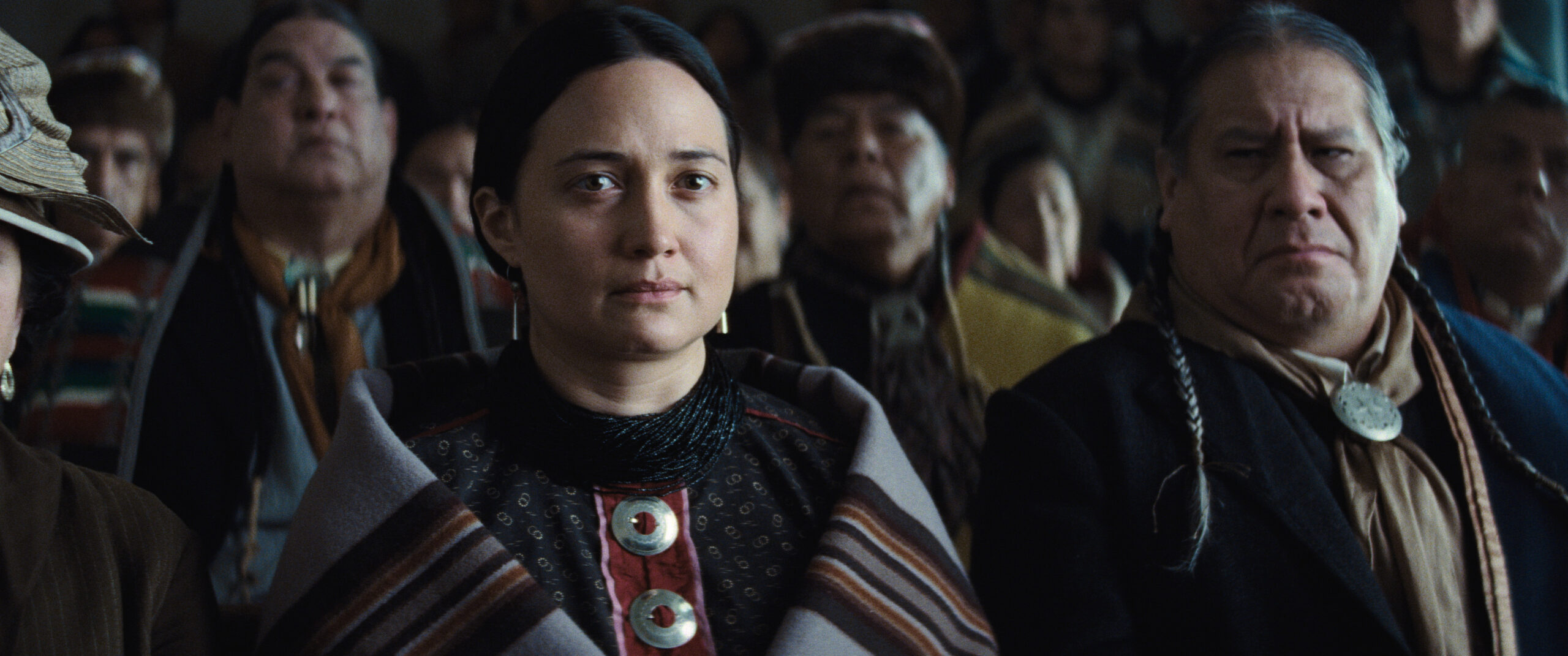
She references Chief Dan George from Tsleil-Waututh Nation in B.C., nominated in 1970 for Little Big Man, Graham Greene from Six Nations in Ontario, nominated in 1990 for Dances With Wolves, and Tahitian actress Jocelyn LaGarde, nominated in 1966 for Hawaii. Other Indigenous acting nominees include Māori stars Merle Oberon (The Dark Angel) and Keisha Castle-Hughes (Whale Rider) and Roma’s Yalitza Aparicio.
“What it means for representation in a broader sense is that there’s been a character, there’s been a story, that has cared enough to invite the audience to care about a human,” Gladstone continues. “That’s hopefully the shifting of the tide. That’s the testament [to] what we’ve done with it, what Marty helmed and guided, what the Osage Tribal Nation, all of the people who poured everything into this and trusted it so much. It can just prove to people that, yeah, you can make money by listening to people’s stories. This is what people want to hear. This is what people want to know about.
“It might be completely naive, me sitting here at this point in whatever my career is, versus what this giant industry is. But at the heart of it, that’s what’s true. People care about people. I think a lot of times, we don’t give audiences enough credit that they’re going to care about a story that focuses on this relationship.”
This Boy’s Life: 30 Years Later
Killers of the Flower Moon gives Scorsese’s muses DiCaprio and De Niro their first opportunity to work together on a feature with their most steadfast director. DiCaprio cheekily pays tribute to the full-circle moment, comparing the chemistry between his character Ernest and De Niro’s Hale to the characters they played 30 years before. “There’s some dynamics from This Boy’s Life in there,” says DiCaprio, referring to the 1993 film that starred him as a child enduring the abuse of De Niro, playing his stepdad.
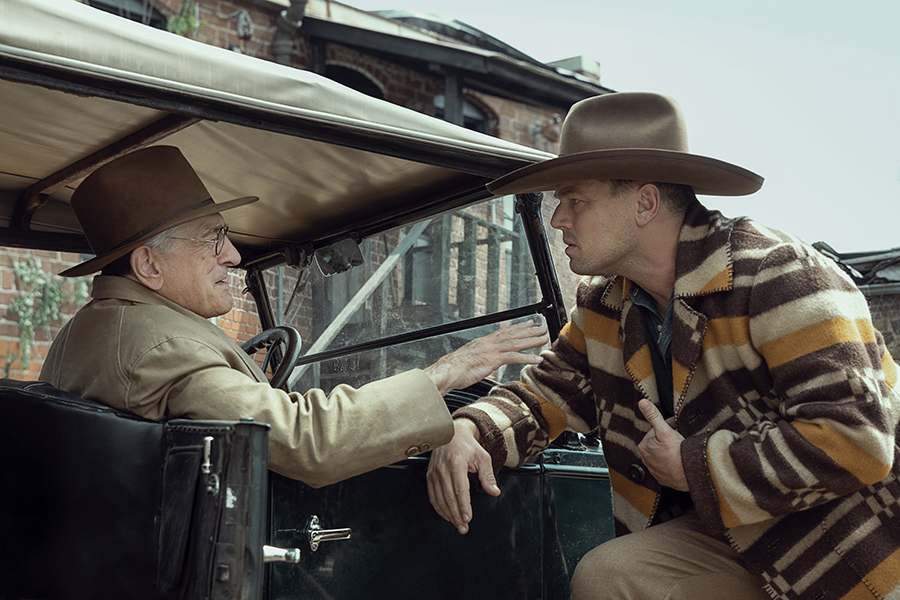
“My first major role in a film was starring opposite Robert De Niro,” says DiCaprio, describing his big-screen journey. “I came from television. I didn’t have a template [for] what acting really was. I had taken acting classes. I had read up on it. But until you see that man walk into the room and the respect that he commands by his sheer presence and his commitment to his craft …”
DiCaprio trails off on tangents about De Niro’s legendary career before returning to their own history. “Having him recommend me as an actor to Scorsese, and then having been able to do so many films with [Scorsese], and then here we are 30 years later, is a very special and meaningful moment for me.”
Narrative Sovereignty
“We don’t trust people to tell our story,” says Osage Nation Chief Geoffrey Standing Bear on a recent Zoom call with Zoomer. The 70-year-old is speaking about the wariness he and his community have when it comes to settlers writing books or making movies about their history and their ancestors. “We have our elders in our minds and in spirit with us. We all have responsibility to carry on their experiences.”
Standing Bear says he expressed many of his concerns in a meeting with Scorsese and DiCaprio ahead of the making of Killers, explaining that he was worried “the Osages were just going to be portrayed as dead bodies.”
According to Standing Bear, Scorsese reassured him that he was going to make the film immersed in the culture, with Osage involvement in everything from costuming to the camera department. Scorsese also explained his approach for Killers, telling a story about trust between a man and a woman mirroring the Osage and outside world, “and the betrayal of that trust.”
Chief Standing Bear, along with everyone else we spoke to from the cast and the Osage community, testifies that Killers is told in the most respectful and communal way possible. But Scorsese is still taking up space as white settler filmmaker telling an Indigenous story, replicating the same extractive dynamic that Hollywood has imposed on Indigenous narratives for a century.
Historically (and still today), studio gatekeepers would rather have white settler filmmakers tell Indigenous stories rather than trust or invest in storytellers from the communities being represented. It’s a harmful setup, refusing narrative sovereignty to Indigenous communities while allowing for a dehumanizing history of misrepresentation onscreen to continue. We’ve gone from seeing Indigenous communities as “the savages” in John Wayne westerns to the traumatized victims in Taylor Sheridan’s white-centring fantasies (Wind River, Yellowstone).
“I’m glad to see so many of our people coming up today,” says Chief Standing Bear, referring to the Indigenous storytellers in the business pushing back against modern tropes while making movies and television that are just as deserving of attention as Scorsese. He mentions Gladstone, who he says is part of their community now, as well as Sterlin Harjo, the co-creator and showrunner of Reservation Dogs, a sublime dramedy about the young generation in Oklahoma’s Muscogee Nation.
In Canada, we have fantastic work coming from Danis Goulet (Night Raiders), Elle-Máijá Tailfeathers (The Body Remembers When The World Broke Open), Alethea Arnaquq-Baril (Angry Inuk) and Jennifer Podemski (Little Bird).
“We have some wonderful films,” says Canadian Cree and Metis actor and icon Tantoo Cardinal about her small role in Killers of the Flower Moon. “We have documentaries, docudramas, features, short films and festivals. We have a whole history of filmmaking … It takes a filmmaker of Scorsese’s stature and expertise to be able to do a film with this subject and story and have anybody see it.”

Spoiler Alert: The following portion of the conversation reveals details regarding the ending of Killers of the Flower Moon.
Scorsese and Misrepresentation
Scorsese is very cognizant of the history of misrepresentation and his relationship to the story. He even included a coda in Killers of the Flower Moon to express those “ill-feelings,” a scene where he peels back the curtain and makes an appearance, signalling to the audience his position as storyteller in this narrative.
The final scene is a behind-the-scenes look at a radio play production, where the on-air performers are narrating the story of the Osage murders in sensational true-crime fashion before a live audience.
“They weren’t very good,” says Scorsese, referring to the actual radio plays that tell the Osage story, which were just more examples of white lenses framing violence committed against an Indigenous community as entertainment. In his authentic (but also meta) version of such storytelling, Scorsese confronts that framing while trying to bring his movie to a place of real feeling and empathy.
They shot the radio play in New York, where such shows would typically be broadcast. Coincidentally, the only location available to Scorsese with a stage for them to use at the time was the Bronx’s Cardinal Hayes High School. “So I’m back at my high school,” he says laughing.
The radio play finishes with an obituary, a moment where Scorsese tries to change its temperature from crude entertainment to something more solemn. “Every time I read it, it was so moving,” says Scorsese.
He says he couldn’t figure out who should play the man on the microphone reading off the names of the victims, so Scorsese ultimately took the role by presenting himself as a settler storyteller within the film. “I didn’t think I could really direct another actor. I got all these great people. But I don’t know what I could tell this person. I can’t direct it. But I think I could feel it. I thought I’d take a chance. It’s got to come down on me anyway. So I might as well take it.
“Worse comes to worst, it’s a single shot. You can get someone else and we can do a reshoot. And so we did it that day. My wife was there. My daughter. Kids were running around. People were kind of giggling about the radio show. But after I did about four takes, or whatever, it was quiet. And everybody felt it. And I said, ‘I think we got it.’”
Killers of the Flower Moon is in theatres October 20. And pick up the new issue of Zoomer for our cover story with Scorsese and the cast.
* A version of this story was originally published in October 2023.
RELATED:
Killers of the Flower Moon: See the First Trailer for the Martin Scorsese Western Epic
Robert De Niro at 80: Revisiting the Time He (Sort of) Opened Up About Family and Film